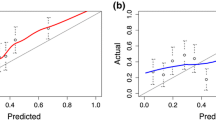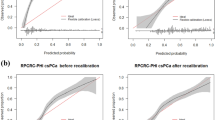Abstract
Objective
To compare the prostate cancer prevention trial risk calculator (PCPT-RC) and European randomized study of screening for prostate cancer risk calculator (ERSPC-RC) in a unique unscreened population from the West of Ireland.
Patients and methods
Data was prospectively recorded for all 556 consecutive men who underwent prostate biopsy at our institution as part of the Rapid Access Prostate Assessment Clinic program in Ireland. The estimated probabilities of detecting prostate cancer and high-grade disease were calculated using the PCPT and ERSPC risk calculators. For each calculator the discriminative ability, calibration and clinical utility was assessed.
Results
Prostate cancer was detected in 49 % and high-grade prostate cancer in 34 % of men. Receiver operating characteristic curve analysis demonstrated that the PCPT-RCs outperformed the ERSPC-RCs for the prediction of prostate cancer areas underneath the ROC curve (AUC 0.628 vs. 0.588, p = 0.0034) and for the prediction of high-grade prostate cancer (AUC 0.792 vs. 0.690, p = 0.0029). Both risk calculators generally over-predicted the risk of prostate cancer and high-grade disease across a wide range of predicted probabilities. Decision curve analysis suggested greater net benefit using the PCPT-RCs in this population.
Conclusions
Multivariable nomograms can further aid patient counselling for early prostate cancer detection. In unscreened men from Western Ireland, the PCPT-RCs provided better discrimination for overall prostate cancer and high-grade disease compared to the ERSPC-RC. However, both tools overpredicted the risk of cancer detection on biopsy, and it is possible that a different set of predictive variables may be more useful in this population.



Similar content being viewed by others
References
Carter HB, Albertsen PC, Barry MJ et al. (2013) American urological association (AUA) guideline GUIDELINE American urological association early detection of prostate cancer. 1–28
National Institute for Health and Care Excellence (2014) Prostate cancer: diagnosis and treatment. NICE ISBN: 978-1-4731-0404-4
Heidenreich A, Bastian PJ, Bellmunt J et al. (2013) Guidelines on prostate cancer
Chou R, Croswell JM, Dana T et al (2011) Screening for prostate cancer: a review of the evidence for the US preventive services task force. Ann Intern Med 155:762–771
Ginsburg GS, Willard HF (2009) Genomic and personalized medicine: foundations and applications. Transl Res 154:277–287. doi:10.1016/j.trsl.2009.09.005
Thompson IM, Ankerst DP, Chi C et al (2006) Assessing prostate cancer risk: results from the prostate cancer prevention trial. J Natl Cancer Inst 98:529–534. doi:10.1093/jnci/djj131
Roobol MJ, Steyerberg EW, Kranse R et al (2010) A risk-based strategy improves prostate-specific antigen-driven detection of prostate cancer. Eur Urol 57:79–85. doi:10.1016/j.eururo.2009.08.025
Burns R, Walsh B, Sharp L, O’Neill C (2012) Prostate cancer screening practices in the republic of Ireland: the determinants of uptake. J Health Serv Res Policy 17:206–211
Health Service Executive National Cancer Control Programme Ireland. http://cancercontrol.hse.ie/. Accessed 9 Jan 2014
NCCP Prostate Cancer Referral Guideline (2011) Version 1.3 January 2011. In: Irish Natl. Cancer Control Progr. http://www.healthlink.ie/Oncology/NCCP%20Prostate%20Cancer%20Referral%20Guideline%20Version%201.3%20January%202011.pdf. Accessed 2 Mar 2014
University of Texas Health Science Center : individualised risk assessment of prostate cancer PCPTRC 1.0
SWOP Risk Calculator 3. http://www.prostatecancer-riskcalculator.com/seven-prostate-cancer-risk-calculators. Accessed 1 Sep 2014
Bewick V, Cheek L, Ball J (2004) Statistics review 13: receiver operating characteristic curves. Crit Care 8:508–512. doi:10.1186/cc3000
DeLong ER, DeLong DM, Clarke-Pearson DL (1988) Comparing the areas under two or more correlated receiver operating characteristic curves: a nonparametric approach. Biometrics 44:837–845
Steyerberg EW (2009) Clinical prediction models: a practical approach to development, validation, and updating. Springer
Vickers AJ, Elkin EB (2006) Decision curve analysis: a novel method for evaluating prediction models. Med Decis Making 26:565–574. doi:10.1177/0272989X06295361
Irish National Cancer Registry (2011) Cancer in Ireland 2011: annual report of the national cancer registry. In: Cancer Irel. 2011. http://www.ncri.ie/sites/ncri/files/pubs/Cancer in Ireland 2011 annual report of thenational cancer registry.pdf. Accessed 9 Jan 2014
Trottier G, Roobol MJ, Lawrentschuk N et al (2011) Comparison of risk calculators from the prostate cancer prevention trial and the European randomized study of screening for prostate cancer in a contemporary Canadian cohort. BJU Int 108:E237–E244. doi:10.1111/j.1464-410X.2011.10207.x
Zhu Y, Wang J-Y, Shen Y-J et al (2012) External validation of the prostate cancer prevention trial and the European randomized study of screening for prostate cancer risk calculators in a Chinese cohort. Asian J Androl 14:738–744. doi:10.1038/aja.2012.28
Cavadas V, Osório L, Sabell F et al (2010) Prostate cancer prevention trial and European randomized study of screening for prostate cancer risk calculators: a performance comparison in a contemporary screened cohort. Eur Urol 58:551–558. doi:10.1016/j.eururo.2010.06.023
Ankerst D, Boeck A, Freedland S (2012) Evaluating the PCPT risk calculator in ten international biopsy cohorts: results from the prostate biopsy collaborative group. World J 30:181–187. doi: 10.1007/s00345-011-0818-5.Evaluating
Roobol MJ, Nieboer D, Houlgatte A et al (2013) 2054 Reducing unnecessary biopsies for suspicion of prostate cancer: extension and validation of an ERSPC based risk calculator with phi and comparison with the PCPT risk calculator including% free and-2 PROPSA. J Urol 189:e843
Conflict of interest
DL and BW’s research is supported by the Irish Cancer Society as part of the Prostate Cancer Research Consortium, The Urology Foundation and the Irish Research Council. SL has received an honorarium for speaking at a cancer meeting; and this was unrelated to this study. BK, RF, JF, ER, GD and KW have no conflict of interest to declare.
Ethical standards
All men in this study consented to undergo a 12 core sextant prostate biopsy and to participate in this institutional review board approved cohort study.
Author information
Authors and Affiliations
Corresponding author
Rights and permissions
About this article
Cite this article
Lundon, D.J., Kelly, B.D., Foley, R. et al. Prostate cancer risk assessment tools in an unscreened population. World J Urol 33, 827–832 (2015). https://doi.org/10.1007/s00345-014-1365-7
Received:
Accepted:
Published:
Issue Date:
DOI: https://doi.org/10.1007/s00345-014-1365-7




